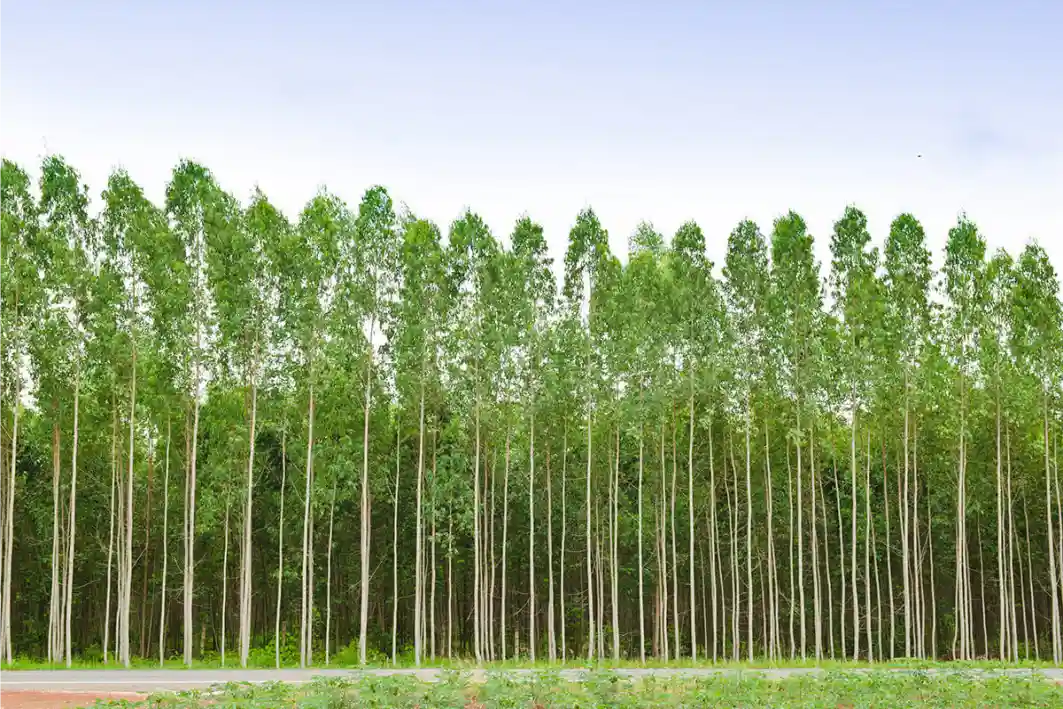Eucalyptus is one of the most valuable materials in the world, being available in 900 species and having enormous economic importance to more than 100 countries. Eucalyptus is one of the most planted trees in the world; being the primary resource for paper production, due to its fast growth, high productivity, high bulk density, fiber properties, carbon storage and variety. The team at Timbeter has successfully developed method to measure the volume of eucalyptus, bringing accurate results to several clients all over the world.
There are many different methods to measure eucalyptus, the most common way is via visual observation accompanied by the coefficient of pile density or air filling factor, which determines the amount of wood without air and bark. The volume is then calculated by the density coefficient of the stack multiplied by the cube (cubing of a pile of logs means multiplying the stack width, average log length, and average pile height). Although a fast method, its subjectivity reduces reliability, and the margin of error can vary between 5 and 10%. Because eucalyptus is a highly prized wood, this margin of error can generate a material loss and generate disputes between both sellers and buyers.
Additionally, eucalyptus can also be measured in stere (in some places, commonly referred as “Stere”):
Stere (st): is the volume that is obtained by measuring the stack of wood logs, including the amounts of air between the logs.

(https://www.picbleu.fr/page/comment-calculer-le-prix-du-stere-de-bois-de-chauffage)
It is customary to measure the volume in stere by cubing a pile of logs by multiplying the following: stack width, average log length and average pile height. The results expressed in stere or cubic meters of stacked wood. If you use a filling factor of 100% with Timbeter, then you will obtain the pile volume.
Also, in stere measurement , the measured wood can be converted to the solid volume through two factors:
Stacking Factor: (SF) = (Stacked Volume) / (Solid Volume) (values greater than or equal to 1 st/m³)
Cubication Factor (CF) = (Solid Volume) / (Stacked Volume) (values less than or equal to 1 m³/st)
The central question is that due to innumerable different technical and human parameters, the results can change the values when you convert volumes. Simply put,, working with fixed values is not recommended as it increases the margin of error and, consequently, the number of complaints.

(https://www.brandhout.com/nl/st%C3%A8re-hout-m3)
For example, some values of the stacking factor may differ and increase the margin of error, like forest species, tree age, log diameter, log length, defects, log moisture, among others.
For thicker logs, the methods used in addition to the pile density coefficient are more traditional – mathematical formulas for volume (JAS, Hubber, Doyle) – are used. It is up to the parties to decide which formula used so that there are no differences in the measurements.
Plus, should you use one of these measurements, you can acquaint yourself with which one of the 11 Roundwood formulae you can use. Please note that compared to your location, will determine which formulae you will use.
In view of the challenges posed by manual measurement through factorization, Timbeter is a simple solution making strides within the industry; besides taking precise measurements, with a margin of error between 0.5 and 1.5%, the software can track piles and allow sharing of measurement information, improving the work processes of all parties.

For buyers and sellers, exporting eucalyptus has significant global commercial value; yet this brings critical challenges that must be overcome. To simplify the process,, Timbeter have developed, in addition to the Timbeter Container, a specially crafted tool for exporting large-scale eucalyptus. Timbeter’s pioneering smart device app can read the QR code tags that are fastened to the logs. As this is a unique feature available on request – please on a contact us to trial this feature.
At Timbeter, our mission is to make the work of forestry professionals simpler and better. Because eucalyptus and, in general, pulpwood is a high-productivity resource with rapid growth and global transportation, we know that the ideal way to calculate the logs must be accurate and fast. You can begin getting started by either registering on our website or by downloading our app.
References:
http://cmq.esalq.usp.br/wiki/lib/exe/fetch.php?media=publico:metrvm:metrvm-2002-n02.pdf
http://www.eucalyptus.com.br/artigos/news48_Toras_Empilhadas.pdf
http://rpm.org.br/rpm/img/conteudo/files/RPM%20%2083%20-%20Sobre%20metdos%20de%20obteno%20do%20volume%20de%20toras%20de%20madeira.pdf
